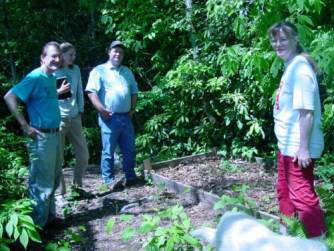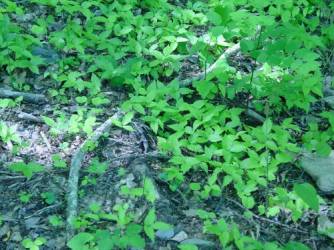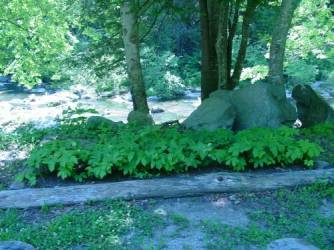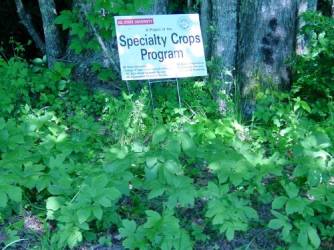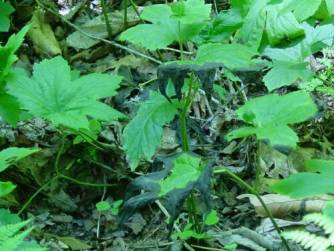Native Medicinal Plant on-Farm Trials-2002 Report
go.ncsu.edu/readext?454049
en Español / em Português
El inglés es el idioma de control de esta página. En la medida en que haya algún conflicto entre la traducción al inglés y la traducción, el inglés prevalece.
Al hacer clic en el enlace de traducción se activa un servicio de traducción gratuito para convertir la página al español. Al igual que con cualquier traducción por Internet, la conversión no es sensible al contexto y puede que no traduzca el texto en su significado original. NC State Extension no garantiza la exactitud del texto traducido. Por favor, tenga en cuenta que algunas aplicaciones y/o servicios pueden no funcionar como se espera cuando se traducen.
Português
Inglês é o idioma de controle desta página. Na medida que haja algum conflito entre o texto original em Inglês e a tradução, o Inglês prevalece.
Ao clicar no link de tradução, um serviço gratuito de tradução será ativado para converter a página para o Português. Como em qualquer tradução pela internet, a conversão não é sensivel ao contexto e pode não ocorrer a tradução para o significado orginal. O serviço de Extensão da Carolina do Norte (NC State Extension) não garante a exatidão do texto traduzido. Por favor, observe que algumas funções ou serviços podem não funcionar como esperado após a tradução.
English
English is the controlling language of this page. To the extent there is any conflict between the English text and the translation, English controls.
Clicking on the translation link activates a free translation service to convert the page to Spanish. As with any Internet translation, the conversion is not context-sensitive and may not translate the text to its original meaning. NC State Extension does not guarantee the accuracy of the translated text. Please note that some applications and/or services may not function as expected when translated.
Collapse ▲This is a 2002 report from a NC Specialty Crops Program Project. It is posted for historical reference purposes.
Reviewed by Jeanine Davis, NC Alternative Crops & Organics Program, Department of Horticultural Science, NC State University on 10/13/2022.
PROJECT LEADER(S): Randy Collins
TYPE OF PROJECT: On-farm trial
LOCATION: Graham, Cherokee, and Clay counties
IMPACT
The growing medicinal plant and natural products industries offer opportunities for North Carolina farmers to diversify and supplement farm income with new specialty crops. The goal of this project is to introduce growers in western North Carolina to potential crops in this market, and to begin to research cultivation techniques for these plants. Through education, outreach, and research, promising crops will become established alternatives for growers in North Carolina.
INTRODUCTION
Goldenseal, ginseng, and ramps are native plant species with established or growing representation in the natural products industry. Goldenseal and ginseng are highly prized in medicinal markets, while ramps are popular for culinary uses. Conditions in western North Carolina are favorable for these plants, but production protocols have yet to be established. In these preliminary studies, local growers and residents became involved in determining effective methods for producing these crops on a commercial basis.
METHODS
Goldenseal, ramp, and ginseng plants were given to approximately 20 cooperating farms in the form of plugs, rootstock, or seed. These materials were planted by cooperators according to the instructions of Specialty Crops Program Leader, Jeanine Davis. Most test trials are in the form of 10 ft. X 12 ft. plots placed in wild-simulated positions. Each cooperator keeps a record of how each plot was planted, the date, weather conditions, and any other significant observations. Plots are monitored each year for disease incidence, growth rate, flowering/fruiting, etc., and results are recorded regularly.
RESULTS
Public interest in the project has allowed the involvement of a considerable number of cooperators. The disease problems seen during the first year were greatly improved during the 2002 growing season. About 95% of the plots had little or no disease, growth rates were good, and reproduction of plant materials was noticed in many of the plots. Little to no herbicides, fungicides, or insecticides had to be used this year.
CONCLUSION
Results have been encouraging in the second year of this on-going project. Growers are gaining experience producing these new woodland botanicals. As a group, they are developing markets and value-added products. Probably the most important impact this project has had is the confidence and sense of engagement it has fostered among the growers involved. In addition to helping these growers produce their first crops, these replicated plots will provide yield data that will be so important in the development of production budgets for them to use when trying to obtain business loans. Additional research on production techniques is needed to make particular medicinal crops a viable competitor on a large commercial scale.
PHOTOS



